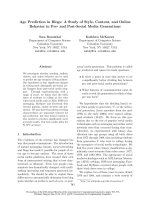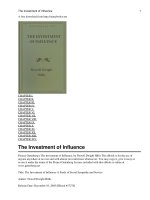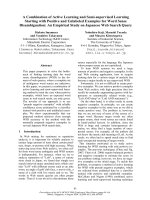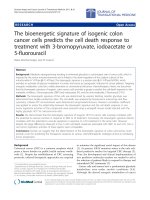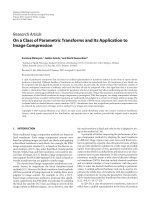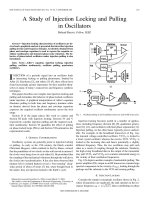A study of bloating symptomatology, the role of gastrointestinal transit and the response to treatment with the 5 HT4 receptor agonist in patients with bloating predominant irritable bowel syndrome
Bạn đang xem bản rút gọn của tài liệu. Xem và tải ngay bản đầy đủ của tài liệu tại đây (850.13 KB, 144 trang )
A STUDY OF BLOATING SYMPTOMATOLOGY,
THE ROLE OF GASTROINTESTINAL TRANSIT AND
THE RESPONSE TO TREATMENT WITH THE 5-HT4
RECEPTOR AGONIST IN PATIENTS WITH
BLOATING PREDOMINANT
IRRITABLE BOWEL SYNDROME
YANG MEI
(MBBS, CSU)
A THESIS SUBMITTED
FOR THE DEGREE OF MASTER OF SCIENCE
DEPARTMENT OF MEDICINE
NATIONAL UNIVERSITY OF SINGAPORE
2006
ACKNOWLEDGEMENTS
I would like to express my sincere thanks to my supervisors, Professor Ho
Khek Yu and Professor Gwee Kok Ann, for their invaluable advice and guidance
throughout the course of this project. I would also thank Dr. Shuter Borys for his
great support in scan data analysis.
Many thanks to Ms.Luo Fenfang, Ms.Ng Siew Mei, Mr. Jerry Lara and other
staff in Nuclear Medicine Department, NUH for their kind help in technical
support in bran scan.
I greatly appreciate Dr Song Guanghui for his important advice and suggestion.
I would also thank Ms Guo Yaling, Ms Adeline Chow, Ms Betty Tan and Mr Lui
Kai Foo for their support, help and friendship. I would like to thank Miss Shila
Rosli, Miss Shiela Pulmones for their kind help in technical support, patient
recruitment and financial management.
At last, special thanks to my loved husband, daughter and my parents for their
love and encouragement.
i
CONTENTS
Page
Title
Acknowledgements i
Contents ii
Summary vi
Chapter 1 Introduction
1
1.1 Irritable Bowel Syndrome (IBS) 2
1.1.1 Overview 2
1.1.2 Epidemiology 3
1.1.3 Diagnosis of IBS 5
1.1.3.1 Diagnosis Criteria 5
1.1.3.2 Diagnostic Strategy 8
1.1.4 Pathophysiology of IBS 11
1.1.4.1 Altered motility 11
1.1.4.2 Visceral Hypersensitivity 12
1.1.4.3 Psychopathology 14
1.1.4.4 Stress 15
1.1.4.5 The brain-gut interaction 18
1.1.5 Treatment 21
1.1.5.1 Non-pharmacological therapies 21
1.1.5.2 Pharmacological treatment 23
1.2 Bloating in IBS 27
ii
1.2.1 Overview 27
1.2.2 Pathophysiology of bloating 29
1.2.2.1 Mechanisms of distorted sensation 29
1.2.2.2 Mechanisms of physical abdominal expansion 30
1.2.2.3 Mechanisms of abdominal muscular activity 33
1.3 The role of Serotonin in IBS 34
1.3.1 Synthesis, distribution and metabolism of Serotonin 35
1.3.2 Serotonin in GIT 37
1.3.3 Effects of 5-HT4 agonist on IBS 38
1.4 Hypothesis and Aims 41
Chapter 2 Symptom Profile in Irritable Bowel Syndrome Patients
with Bloating
43
2.1 Introduction 44
2.2 Subjects and methods 45
2.2.1 Subjects 45
2.2.2 Methods 47
2.2.3 Statistical analysis 48
2.3 Results 49
2.3.1 Demographic Characteristics 49
2.3.2 Characteristics of the sensation of bloating 50
2.3.3 Bowel habits 54
2.3.4 Symptom score and HAD score 56
2.3.5 Survey of IBS education 58
iii
2.4 Discussion 59
Chapter 3 Impaired Intestine Transit in Non-Diarrhea Irritable
Bowel Syndrome Patients with Bloating
64
3.1 Introduction 65
3.2 Subjects and methods 67
3.2.1 Subjects 67
3.2.2 Procedure 68
3.2.3 Scintigraphic analysis 70
3.2.4 Statistical analysis 71
3.3 Results 73
3.3.1 Demographic characteristics 73
3.3.2 Transit times 75
3.3.3 Bloating symptom and girth measurement 82
3.4 Discussion 84
Chapter 4 Effect of 5-HT4 Agonist Tegaserod on Non-Diarrhea IBS
with Bloating –A Randomized, Double Blind, Placebo
Controlled Study
89
4.1 Introduction 90
4.2 Subjects and methods 92
4.2.1 Subjects 92
4.2.2 Methods 93
4.2.3 Statistical analysis 96
4.3 Results 97
4.3.1 Demographic characteristics 97
iv
4.3.2 Symptoms characteristics in treatment groups 98
4.3.3 Transit measurements 104
4.4 Discussion 110
Chapter 5 References
115
Appendix
Appendix A Gastrointestinal Symptoms Questionnaire
Appendix B Hospital Anxiety and Depression (HAD) Scale
Appendix C Symptoms Score
Appendix D Bowel Diary
v
Summary
Irritable bowel syndrome (IBS) is a chronic disorder with symptoms of
abdominal pain, discomfort or bloating associated with alterations in bowel habits
without organic disease. Bloating is a troublesome and poorly understood
symptom in IBS. It has been suggested that impaired gut motility and altered
sensitivity may be the mechanism of bloating. We thus hypothesized that 1)
bloating predominant IBS patients in Asia have delayed intestinal transit; and 2)
tegaserod could improve bloating and intestine transit in these patients. Therefore,
the objective of this study is to investigate the symptomatology of bloating, the
role of gastrointestinal transit and effect of tegaserod in non-diarrhea IBS patients
with bloating.
In the first part of this thesis, the symptoms profiles of non-diarrhea IBS
patients with bloating were assessed. It was showed that there were more common
complaints with upper abdominal bloating associated with moderate bowel
disturbance in these patients. Using psychological questionnaires, these IBS
patients were observed to have higher HAD scores than healthy controls.
Additionally, the results of IBS education survey suggested that more IBS health
education and health-care costs about IBS should be provided to Asian patients.
vi
The second part of this thesis was to investigate the gastrointestinal transit in
non-diarrhea IBS patients with bloating and normal controls, using
radioscintigraphic method. The results showed these bloating IBS patients had
significant slower small bowel transit than normal controls. However, there were
no significant differences in the gastric emptying half-time and ileocaecal transit
times between the IBS patients and normal controls. Meanwhile, it was found that
majority of these IBS patients and none of the normal controls reported bloating
during the scan.
In the third part of this thesis, the effect of 5-HT4 receptor agonist Tegaserod
was investigated in a randomized, double blind and controlled study. Compared
with placebo, administration of oral tegaserod 6mg twice a day for two weeks
significantly alleviated bloating symptom in non-diarrhea IBS patients with
bloating. It was also showed partial improvement in bowel habits after tegaserod
treatment. On the other hand, tegaserod accelerates small bowel transit time
without any effect on gastric emptying and ileocaecal transit time. Moreover, the
improvement of bloating score is positively correlated to the decrease of small
bowel transit time in tegaserod group.
In conclusion, we demonstrated that non-diarrhea IBS patients with bloating in
Asia presented with upper abdominal bloating, moderate bowel disturbance and
vii
higher HAD scores than normal controls. Moreover, these patients have impaired
small intestinal transit. Tegaserod 6 mg b.i.d alleviated the bloating symptoms and
bowel disturbance. In addition, tegaserod significantly accelerated small bowel
transit in bloating predominant IBS patients compared with placebo. The findings
suggested that tegaserod could provide effective treatment for non-diarrhea IBS
patients with bloating.
viii
Chapter 1
Introduction
1
1.1 Irritable Bowel Syndrome (IBS)
1.1.1 Overview
Irritable bowel syndrome (IBS) is a chronic disorder with symptoms of
abdominal pain, discomfort or bloating associated with alterations in stool
frequency and/or consistency and the absence of detectable organic disease. IBS is
a very common functional bowel disorder, which are markedly influenced by
psychological factors and life style. Although not life threatening, it is one of the
major diagnoses in outpatient clinic and the most frequent reason for consultation
with a gastroenterologist (Harvey, 1983; Drossman, 1997). It is clear that
symptoms that are suggestive of IBS are common, however only a quarter of these
symptomatic patients seek medical advice for their symptoms (Drossman et al,
1992). Despite this, it is estimated that IBS is responsible for approximately 2.4 to
3.5 million physician visits per year and represents 12% of primary care visits and
28% of referrals to gastroenterologists (Sandler et al, 1990). In Singapore, a study
revealed that IBS makes up 17% of new referrals to a tertiary gastroenterology
centre (Kang et al. 1994).
Since there is no biological marker that can identify patients with this disorder,
IBS traditionally is viewed as a diagnosis of exclusion to making a positive
diagnosis based on standard criteria. The diagnosis of IBS is based on
characteristic symptoms and several symptom-based criteria for IBS have been
developed to facilitate and standardize its diagnosis (Somers et al, 2003).
According to the bowel pattern, it is divided to three types of IBS: constipation-
2
predominant IBS (C-IBS), diarrhea-predominant IBS (D-IBS), and alternating IBS
(A-IBS).
IBS substantially impairs the quality of life (QOL) of affected individuals.
The QOL in patients who have IBS is worse than that of the general population
and is similar to that of patients who have any of several significant medical
conditions (Gralnek et al, 2000). Patients with IBS have 2 to 3 times work
absenteeism than other employees (Drossman et al, 1993), and the health care
costs entailed in caring for IBS patients is 1.6 times that of other patients (Talley
et al, 1998). Moreover, IBS patients are more likely to exhibit health care-seeking
behaviors that are related to gastrointestinal and non-gastrointestinal complaints.
The annual economic consequences of IBS are substantial. It was estimated that
IBS accounts for approximately $1.7 to $10 billion in annual direct medical costs
per year in United States (Cash et al, 2004). Due to limited understanding of this
disorder and lack of gold standard for diagnosis, irritable bowel syndrome is
certainly an important research area. Therefore it gains increasing attention and
interests from clinicians, researchers and pharmaceutical industry.
1.1.2 Epidemiology
IBS epidemiology varies from different definition. The recent Rome I and
Rome II criteria are more restrictive than the earlier Manning criteria. IBS
prevalence and gender distribution are different between the west and Asia
(Cremonini et al, 2005). In West the prevalence of IBS in the community is
reported to be 10%-20% (Sandler et al, 1990). A community survey using the
3
Manning criteria showed that IBS affected 22% of the British population aged
between 20 to 90 years. Another study using the same criteria, found the
prevalence was 17% in a different age group (30-64 years) (Talley et al, 1991).
IBS symptoms were found in 9.4% of the United States population by Rome
criteria (Drossman et al, 1993). In the U.S. Householder Survey (Drossman et al,
1993), IBS was present in 14.5% of women but in only 7.7% of men. Similar
gender disparity was shown in other studies from western country which reported
IBS affected females approximately twice as often as males (Jones et al, 1992;
Heaton et al, 1992).
The prevalence rates in Asian studies have been generally lower than in the
west. The female :male ratio across Asian studies is around 1.5:1 (Cremonini et al,
2004) Actually, a study on urban populations in China report rates similar to
those observed in the west (Xiong et al, 2004). It is found that the prevalence is
less than 5% in Thailand (Danivat et al, 1988). In Singapore, a population-based
cross-sectional survey conducted by a team from the National University of
Singapore (Gwee et al, 2004), where 2,276 people were interviewed in their
homes, IBS was found to affect about 1 in 10 people. Women between 20 and 40
years of age had the highest frequency (16%) and men aged 50 years and above
had the lowest (5%). However, an early study reported that 81% of IBS patients
were male (Bordie, 1972). There are differences between western and eastern
countries in disease epidemiology. In addition, IBS seems to be more common in
younger age groups. It was founded that only about 10% of IBS patients are
between 60-70 years old (Harvey et al, 1987).
4
1.1.3 Diagnosis of IBS
It is very important to make a correct diagnosis of IBS since it reassures
patients about the prognosis of their disease and provide a therapeutic strategy on
controlling their symptoms, such as pain/bloating, constipation, diarrhea. The
differential diagnosis in patients with symptoms that are suggestive of IBS is
broad. IBS has historically been viewed as a diagnosis of symptom-based rather
than as a primary diagnosis. However, for a variety of reasons, the diagnosis of
IBS is not an easy task compared with other organic diseases. First of all,
clinicians are not confident to use positive symptom criteria to detect IBS which
implies IBS remains a diagnosis of exclusion. Secondly, with the lack of a
biological marker, symptoms of IBS patients are not specific for the syndrome and
are characterized by a significant inter-and intra-individual variability (De Giorgio
et al, 2004).
IBS patients can be classified by their predominant symptom
and by their stool
frequency, stool form, and stool passage. Accordingly, IBS may be constipation-
predominant,
diarrhea-predominant, or alternating at varying times. This
classification will help practitioners to plan a diagnostic and therapeutic strategy
(Ringel et al, review 2001).
1.1.3.1 Diagnosis criteria
Over the past decades, several groups have developed symptom-based criteria
to help researchers and physicians in identifying patients with IBS. In 1978
Manning et al were the first to describe six key abdominal/intestinal symptoms,
5
now referred to as 'Manning criteria', to help the diagnosis of IBS. Those symptom
criteria distinguish patients with IBS from
those with organic intestinal diseases
(Manning et al, 1978) (Table 1-1). Kruis et al added other criteria, including a
requirement for symptoms to have been present for more than two years and the
use of symptom complexes that increase the chances of making a positive clinical
diagnosis (Kruis et al, 1984). Rome I and more recent Rome II (Table1-1),
developed by multinational research groups, provide a uniform framework for the
selection of patients in diagnostic and therapeutic trials of IBS.
In recent years, the application of these criteria to patients in clinical practice
has been encouraged. Studies found that the Rome II criteria are specific for IBS
and have the advantage of being easier to recall and use than the older Manning or
Rome I criteria (Drossman et al, 2002). However, recent evidence suggests the
Rome II may not be as sensitive as the Rome I criteria, mainly because of the
more restrictive temporal pain requirement that is associated with Rome II
(Vanner et al, 1999; Chey et al, 2002). This means that patients fulfilled with IBS
criteria are likely to suffer from IBS, while those patients who do not fulfill the
criteria still ultimately end up with a diagnosis of IBS (Cash, 2004). Overall, the
general view is that the Rome II criteria are extremely valuable research tool.
6
Table 1-1. Symptom-based criteria so far established for the diagnosis of IBS
Manning
Pain relieved by defecation
More frequent stools at the onset of pain
Looser stools at the onset of pain
Visible abdominal distension
Passage of mucus
Feeling of incomplete evacuation
Rome I
Abdominal pain or discomfort for at least 3 months with at least 1 of the
following symptoms:
relieved with defecation
associated with change in frequency of stools
Associated with change in form of stools and two or more of the
following symptoms:
altered stool frequency and/or form
altered stool passage
passage of mucus
bloating or abdominal distension
Rome II
Abdominal pain or discomfort for at least 12 weeks in 12 months with at
least two of the following symptoms:
relieved with defecation
associated with change in frequency of stools
Associated with change in form of stools with the following symptoms
supporting irritable bowel syndrome:
altered stool frequency and/or form
altered stool passage
passage of mucus
bloating or abdominal distension
7
1.1.3.2 Diagnostic Strategy
Clinical presentation
The predominant symptom of IBS is abdominal pain/ discomfort associated
with a change in stool frequency or consistency. IBS patients generally experience
relief from the abdominal pain following defecation. They often have problems
passing motion with strain, incomplete feeling or urgency. The most frequent
presentation of IBS is abdominal pain or discomfort accompanied by a change in
stool frequency, passage and mucus in the stool (Hahn et al, 1997). IBS symptoms
are likely to be aggravated by stress, alcohol, or food (Bennett et al, 1998).
Additionally, IBS patients suffering from psychosocial problems may have more
severe IBS symptoms, more frequent health care seeking, and lower health status
and poorer clinical outcome than those without psychosocial disturbance
(Drossman et al, 2000).
Physical examination
IBS patients generally appear to be healthy in physical examination, which
reveal no evidence of organic disease. Although patients with IBS often have
tenderness in the left lower abdomen, over the sigmoid colon, and discomfort
during a digital rectal examination, these findings are neither specific nor sensitive
enough to be helpful in making the diagnosis of IBS (Fielding, 1981). It is also
necessary to exclude other medical disorders with similar clinical presentation.
For example, the anorectal examination should exclude abnormalities in the anal
and rectal region and evaluate the functioning of the pelvic floor muscles. Also,
there are certain symptoms should be viewed as alert signs or "red flags," since
their presence can suggest a diagnosis other than IBS and require further
8
evaluation. These include symptoms that awaken the patient from sleep, first
presentation at an older age, GI bleeding, weight loss, and fever.
Diagnostic testing
Some recent studies have clearly demonstrated that it is unnecessary to apply
extensive diagnostic tests in the evaluation of patients with IBS symptoms without
“red flags”. The initial evaluation could also include the following limited
diagnostic screening tests: complete blood count; a test of sedimentation rate;
Thyroid-stimulating hormone; Ova and parasites in patients with diarrhea; flexible
sigmoidoscopy and screening for occult blood in stool for those less than 50 years
old; colonoscopy for those greater that 50 years of age (Somers et al, review,
2003).
Furthermore, if the initial evaluation shows no signs of organic disorder, the
physician should start symptomatic treatment and the clinical conditions should be
reevaluated within 4-6 weeks. If symptoms make a change or if red flags appear,
further diagnostic tests should be warranted. Additional diagnostic test are usually
based on the predominant clinical symptoms-constipation, diarrhea, pain or
bloating (Drossman et al, 1997). Figure 1-1 summarizes the approach to the
diagnosis of IBS.
9
(abdominal pain/discomfort, change in the stool form or frequency)
Patient with suspected IBS
Assess for presence of alarm features:
History
Age≧50; Unintentional weight loss; Family history of GI malignancy;
Severe unrelenting large volume diarrhea; Fevers, chills, recent travel to
endemic region; Nocturnal symptoms; Hematochezia
Physical exam
Relevant findings (arthritis, skin abnormalities, lymphadenopathy,
abdominal mass)
Alarm feature Alarm feature
present absent
No improvement
Improvement
Directed diagnostic
testing
Make a confident diagnosis of IBS and
initiate therapy based on predominant
symptoms
Follow up in 4-6 weeks
Continue current therapy
Figure 1-1. Evidence-based approach to the diagnosis of IBS (Adapt from Cash
et al, 2004)
10
1.1.4 Pathophysiology of IBS
The pathophysiology of irritable bowel syndrome still remains unknown,
although a variety of postulated mechanisms has been developed as the basis of
IBS for the past decades. It is likely that the IBS represents the expression of
multiple potential pathophysiology factors, which are dysmotility, visceral
hypersensitivity, psychological factors, stress, and abnormal brain-gut responses,
as well as other mechanisms that remain to be elucidated.
1.1.4.1 Altered motility
For many years, researchers focused on the role of abnormal motility in the
pathogenesis of IBS. A number of motor abnormalities have been described in the
colon and small intestine of IBS patients. Patients with predominant symptom of
diarrhea seem to have accelerated whole gut and colonic transit times. Conversely,
decreased transit was revealed in patients who have constipation predominant IBS
(Cann et al, 1983). Intestinal transit studies suggest that the transit of food through
the ileocaecal region may be associated with pain and bloating (Cann et al, 1983;
Trotman et al, 1986). Recently, a study found that IBS patients has impaired
transit and tolerance to intestinal gas and this has been cited as a possible
mechanism for bloating which commonly experienced in IBS patients(Serra et al,
2001). Similarly study demonstrated that rectal distension accelerates gas transit
in healthy subjects, however, it fails in IBS patients with bloating which impairs
their ability to propel and evacuate intestinal gas (Harder et al, 2004).
11
Moreover, abnormal motility patterns have also been found in other regions of
the gastrointestinal tract in IBS patients compared with normal controls (Kellow
and Phillips, 1987). A study found that episodes of pain were associated with
irregular contractile activity in jejunum (Thompson et al, 1979). Another group of
researchers recorded bursts of irregular contractile activity and a reduction I
migrating motor complexes in jejunal motility recordings of IBS and these were
associated with the occurrence of symptoms (Kumar& Wingate, 1985).
However, the described qualitative motility changes lack of specificity.
Differences between IBS patients and healthy subjects more probably reflect a
quantitative rather than qualitative abnormality (Barbara et al, 2004). Hence,
abnormal motility is generally not considered to be the only cause of IBS and
other mechanisms could also be included.
1.1.4.2 Visceral Hypersensitivity
Ritchie first investigated that patients had poor tolerance to balloon
distension of the rectum (Ritchie et al, 1973). After that, decreased sensory
threshold to rectal distension in IBS patients has been described by several
research groups. Increased perception of visceral stimuli also affects other regions
of the gastrointestinal tract, including the sigmoid colon (Delvaux et al, 1999),
ileum (Kellow et al, 1988), duodenum (Accarino et al, 1995) and oesophagus
(Trimble et al, 1995). This lower sensation threshold is likely more frequently in
the diarrhea-predominant IBS group of patients as opposed to the constipation-
12
predominant group, in whom discomfort may be perceived at greater distension
volumes than healthy subjects (Prior et al, 1990).
Meanwhile, several studies revealed that the hypersensitivity is relatively
specific for the viscera. Whitehead et al described that IBS patients have normal
or even increased thresholds for painful stimulation of somatic neuroreceptors
(Whitehead et al, 1990&1994). In a similar study, IBS patients were found to have
higher tolerance and pain thresholds to electrocutaneous stimulation than normal
controls (Cook et al, 1987). Additionally, IBS patients often feel extra-intestinal
symptoms including headaches, chest pain, fatigue, breathlessness, dysuria and
dyspaneuria (Whorwell et al, 1986; Talley et al, 1991; Jones et al, 1992).The
frequency and variety of symptoms suggest that IBS patients may have lower
sensory threshold and have a tendency to perceive pain and/or other symptoms.
The mechanisms for visceral hypersensitivity are completely uncertain. It has
been proposed that multiple factors (genetic, inflammation, motility, local nerve
mechanical irritation, psychological factors) change neuroreceptor and afferent
spinal neurone function and CNS modulation. It may occur as a result of the
recruitment of high threshold silent spinal nociceptors, which downregulate the
central processing of afferent signals (Cervero et al, 1992). In addition, the
increased synaptic activity at the spinal level may lead to a change in the
excitability of dorsal horn projection neurons. So, even when the peripheral
irritation is reduced, the spinal afferents continue to have a pain memory that
amplifies stimuli that is perceived as painful. Finally, dorsal horn neurons are
13
subject to CNS modulation and a loss of descending inhibitory modulation could
further amplify visceral sensation (Drossman, review, 1999).
1.1.4.3 Psychopathology
Over the years of research, psychological factors still represents a main field
of investigation in IBS. Recent study revealed psychosocial and behavioral factors
play a crucial role in IBS patients (Drossman et al, 2000). Also, psychological
factors were suggested to predict the development of IBS after an episode of acute
gastroenteritis in previously asymptomatic individuals (Gwee et al, 1999).
Numerous studies indicate that IBS patients have greater psychological
disturbances than healthy subjects. Patients with IBS are found to have higher
scores for anxiety, depression, hostile feelings, sadness, interpersonal sensitivity
as well as more sleep disturbance compared with healthy controls (Whitehead et al,
1980; Svedlund et al, 1985; Gomborone et al, 1995; Ford et al, 1987). Although
some IBS patients may not meet diagnostic criteria for psychiatric disorders, many
suffer from psychological distress. As a chronic, functional disorder, IBS could be
associated with changed in mood, especially depression and anxiety. Furthermore,
psychiatric comorbidity and impaired psychosocial adjustment are more common
among IBS patients than among healthy controls and higher rates of IBS are found
with psychiatric diagnoses (Fullwood et al, 1995). Many patients with IBS have
counterproductive coping styles, such as cognitions that "catastrophize" symptoms
and life events (Drossman et al, 2000). On the other hand, psychological factors
affect digestive motor and visceral perception (Welgan et al, 1988).
14
Although psychological factors certainly affect to status of IBS symptoms,
they are unlikely the causes of IBS. In fact, patients with IBS who do not see
physicians are psychologically similar to normal subjects. Conversely, frequent
clinic attenders have greater psychosocial disturbances (Smith et al, 1990). IBS
patients report considerably more disability and work absenteeism than normal
subjects (Drossman, 1993).These data indicate that psychosocial difficulties may
influence illness behaviour, fear of cancer, less coping capability and the clinical
outcome. These behaviours are manifest as increased pain reporting, physician
visits, the seeking of alternative medical treatment, and even unnecessary surgery
(Drossman, 1999).
Having IBS or other chronic illness, has psychosocial consequences on one’s
quality of life. So, the model is that psychosocial factors can change/aggravate
clinical symptoms such as pain, bowel movement, and conversely, the chronic
discomforting and disabling symptoms can affects the patients’ psychological
status (further anxiety and depression). Hence, a potentially “vicious circle” could
be used to explain the worsening IBS symptoms and psychological disturbance
(Barbara et al, review, 2004).
1.1.4.4 Stress
The role of stress and stressful event is well recognized in functional GI
disorders. Psychological stress is widely believed to play a major role in IBS, by
precipitating exacerbation of symptoms. Studies investigating the stress in healthy
subjects and experimental animals have clearly demonstrated that psychological
15
and physical stress may induce alterations in GI motility, which in turn could
cause abdominal symptoms and altered bowel habits (Monnikes et al, 2001).
Gorard et al found that acute stresses promoted abnormal motility of the small
intestines in IBS patients, which were different from healthy controls (Gorard &
Farthing, 1994). Several studies reported that disorder bowel function and colonic
motility are associated with stress (Almy et al, 1957; Drossman et al, 1977).
Furthermore, an increased colonic motor response to various psychological (e.g.,
fear, strobe test, mental arithmetic) and physical (e.g. ice water and cold pressure
tests) stressors in IBS patients compared with normal controls was investigated in
several research groups (Narducci et al,1985; Welgan et al, 1988; Fukudo et al,
1993 ). In contrast, no difference was found in esophageal and intestinal motility
between IBS patients and healthy controls (Ayres et al, 1989; Kellow et al, 1992).
Meanwhile, anger stress also inhibits antral motility in IBS patients, which was
not observed in controls (Welgan et al, 2000). Therefore, it is suggested that the
colonic motor response to stress is exaggerated in IBS. This idea is in agreement
with results of electroencephalograms (EEG) studies suggestive of an exaggerated
responsiveness of the brain and the colon to stress in IBS (Nomura et al, 1999). A
recent study has also revealed that chronic stress is highly prevalent in IBS and the
intensity of chronic life stress is significantly associated with the severity and
extent of gastrointestinal and/ or extra-intestinal symptoms in IBS patients
(Bennette et al, 1998).
However, the mechanisms underlying the correlation between stress and gut
are so far not well understood. Stress, defined as an acute threat to the homeostasis
16


